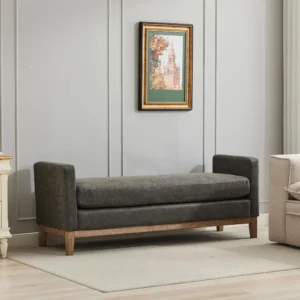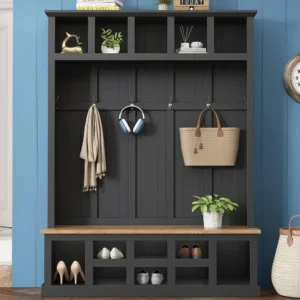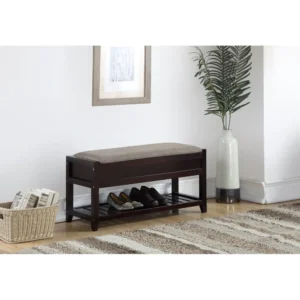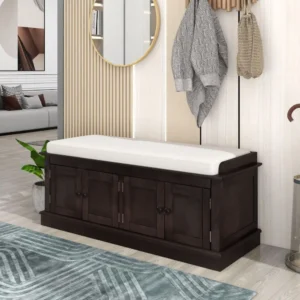1. What Is a Mud Bench and Why Do You Need One?
A mud bench is a practical furniture piece designed for entryways and mudrooms that provides a place to sit while removing shoes and storing everyday items. These versatile pieces combine seating with organizational features like shelves, cubbies, hooks, and sometimes cabinets or drawers to help control clutter in high-traffic areas of your home.
Mud benches serve multiple important functions:
– They create a dedicated space for removing dirty shoes and outerwear
– They provide essential storage for frequently used items
– They establish an organized transition zone between outdoors and your home’s interior
– They add style and character to often overlooked entryway spaces
The appeal of mud benches extends across various home styles – from rustic farmhouse designs with natural wood finishes to sleek modern options with clean lines and minimalist features. Transform entryway space-saving benches can dramatically improve both the function and appearance of your home’s entrance.
Before purchasing a mud bench, understanding the cost factors is essential for making an informed decision. Throughout this guide, we’ll explore the price ranges you can expect, factors that influence cost, where to purchase mud benches, and how to get the best value for your investment.
Whether you’re considering a simple seat for a narrow hallway or a comprehensive mudroom bench system with extensive storage, this guide will help you navigate the options within your budget.
2. Average Mud Bench Cost: What to Expect
When budgeting for a mud bench, prices can vary dramatically based on several key factors. Understanding the typical price ranges across different options helps establish realistic expectations for your project.
Here’s a comprehensive breakdown of what you can expect to pay:
| Mud Bench Type | Price Range | Key Considerations |
|---|---|---|
| Ready-made/Prefabricated | $50-$800+ | • Lower price points for basic designs • Mid-range ($100-$400) for quality options with some storage • Higher end ($400-$800+) for large or feature-rich pieces • Assembly typically required • Limited customization |
| Custom-Built | $500-$5,000+ | • Starting around $500 for basic custom work • $165-$500+ per linear foot for built-ins • Complete custom mudroom systems: $2,695-$6,795+ • Professional installation usually included • Tailored exactly to your space and needs |
| DIY Projects | $100-$500+ (materials) | • Material costs vary based on wood type and quality • Additional costs for tools if not already owned • Time investment required • Results depend on skill level |
Ready-made options from retailers offer the most accessible price points and immediate availability. These affordable entryway bench solutions provide good value for those with standard-sized spaces and basic needs.
Custom-built options represent a higher investment but deliver precisely what you need in terms of size, features, and aesthetics. They’re particularly valuable for unusually shaped spaces or when you have specific storage requirements that prefabricated options can’t fulfill.
Entryway hall trees typically fall on the higher end of the pricing spectrum due to their additional features like coat hooks, mirrors, and more extensive storage capabilities. These all-in-one solutions combine multiple furniture pieces into a cohesive unit.
The wide price variation makes it important to understand exactly what factors drive costs, which we’ll explore in the next section.
3. Key Factors That Influence Mud Bench Prices
Understanding what drives mud bench pricing helps you make informed decisions about where to invest your budget. Several major factors determine the final cost of your mud bench, with each presenting opportunities to either save money or invest in features that matter most to you.
Construction Type
The method of construction significantly impacts price, with mass-produced items generally costing less than handcrafted options. Factory-made benches benefit from economies of scale, while custom pieces reflect the cost of skilled labor and personalized design.
Materials
Material selection is perhaps the most significant cost driver. Solid hardwoods like oak, maple, or cherry command premium prices ($300-800+) compared to pine or engineered woods ($50-300). Premium materials not only cost more initially but often offer greater durability and aesthetic appeal over time.
Size and Dimensions
Larger benches require more materials and labor, directly increasing costs. A compact 36” bench might cost half as much as a 72” version in the same style. Additionally, taller benches with more elaborate storage systems naturally use more materials and require more complex construction.
Features and Functionality
Basic benches with just seating cost significantly less than multi-functional mudroom benches with integrated storage. Each additional feature adds to the price:
– Simple shoe shelf: $20-50 additional
– Closed cabinetry: $100-300+ additional
– Drawers: $50-150+ per drawer
– Cubbies and dividers: $30-100+ additional
– Coat hooks: $5-30+ additional per hook
– Cushions or upholstered seating: $50-200+ additional
Design Complexity
Intricate designs with decorative elements, custom molding, or unusual shapes require more skilled labor and specialized techniques, increasing costs. Simple, straight-line designs are typically more economical while still offering excellent functionality.
Brand and Retailer
Premium furniture brands charge more for similar products compared to budget retailers. While this sometimes reflects quality differences, you’re often also paying for the brand name, warranty, and customer service.
Let’s examine these factors in more detail to help you determine which aspects are worth investing in for your specific needs.
3.1. Construction Type: Prefabricated, Custom, or DIY
The construction approach you choose dramatically impacts both cost and the final result of your mud bench project.
Prefabricated Benches
These ready-made options are mass-produced and sold by furniture retailers and home improvement stores.
Pros:
– Most affordable option ($50-$800)
– Immediate availability
– Wide variety of styles and sizes
– No specialized skills required (simple assembly)
– Predictable quality standards
Cons:
– Limited customization
– May not fit unusual spaces perfectly
– Assembly quality depends on the manufacturer
– May not address unique storage needs
Custom-Built Benches
These made-to-order pieces are designed specifically for your space by professional woodworkers or carpenters.
Pros:
– Perfectly sized for your space
– Tailored to your exact storage needs
– Higher-quality materials and construction
– Professional installation included
– Unique design possibilities
Cons:
– Significantly higher cost ($500-$5,000+)
– Longer wait time (typically 2-8 weeks)
– Requires finding reliable craftspeople
– Permanent addition that stays with the home
DIY Projects
Building your own mud bench allows complete control over design and materials while potentially saving money.
Pros:
– Cost savings on labor ($100-$500+ for materials only)
– Customized to your exact specifications
– Personal satisfaction from creating something
– Can be modified or upgraded over time
Cons:
– Requires tools, skills, and time
– Quality depends on your woodworking experience
– Potential for mistakes and additional costs
– May lack professional finishing touches
For those seeking quality materials and craftsmanship, wood mudroom benches offer durability and classic styling that works in various home designs. The construction approach you choose should align with your budget, timeline, and the importance of customization for your space.

3.2. Materials: Wood Types, Hardware, and Finishes
The materials you choose for your mud bench significantly impact both the price and longevity of the piece.
Wood Options and Their Price Impact
| Wood Type | Price Range | Durability | Appearance |
|---|---|---|---|
| Pine | $50-200 | Moderate | Light, casual, takes paint well |
| MDF/Engineered Wood | $80-300 | Fair | Smooth, uniform, requires sealing |
| Oak | $200-600+ | Excellent | Strong grain, traditional look |
| Maple | $250-650+ | Excellent | Smooth grain, takes stain well |
| Cherry | $300-800+ | Excellent | Rich color that darkens with age |
| Walnut | $350-900+ | Excellent | Dark, sophisticated appearance |
Solid woods cost more but offer greater durability and repair potential. Engineered woods provide cost savings but may not withstand heavy use as well over time.
Hardware Components
Hardware quality directly affects both the appearance and functionality of your bench:
– Basic metal hardware: $10-30 total
– Premium soft-close hinges: $30-100 total
– Decorative pulls and knobs: $5-30+ each
– Heavy-duty storage hooks: $5-20+ each
Finishing Options
Finishes protect your bench while enhancing its appearance:
– Simple paint: $30-80 in materials
– Premium stains and sealers: $50-150 in materials
– Distressed or specialty finishes: $100-300+ in materials or labor
– Upholstered elements: $50-200+ depending on fabric quality
Material selection becomes especially important for benches that will see heavy daily use. For busy families with children and pets, investing in quality materials for your mudroom bench cabinets can provide better long-term value despite higher initial costs.
3.3. Size and Design Features
The dimensions and features of your mud bench directly impact its price, functionality, and visual impact in your space.
Size Considerations
Mud bench pricing typically increases with size:
– Small (24”-36” wide): $50-300
– Medium (36”-60” wide): $150-600
– Large (60”-84” wide): $300-1,000+
– Extra large or L-shaped: $600-5,000+
Height and depth also affect pricing – deeper benches with taller storage components use more materials and cost more to build or ship.
Configuration Options
Different bench layouts come with varying price points:
– Simple straight bench: Base price
– L-shaped corner bench: 1.5-2x the base price
– U-shaped wraparound: 2-3x the base price
Storage Features
Each additional storage feature increases functionality but also adds to the cost:
– Open shelving: $30-100 additional
– Divided shoe cubbies: $50-150 additional
– Overhead cabinets: $150-400+ additional
– Drawers: $50-150+ per drawer
– Lift-top bench storage: $100-300 additional
Additional Design Elements
Specialized features for enhanced functionality:
– Integrated coat rack: $50-200 additional
– Mirror integration: $75-200 additional
– Built-in charging stations: $100-300 additional
– Custom dividers: $30-100+ additional
Especially for smaller homes, best small benches for entryways offer space-efficient solutions that maximize functionality without overwhelming limited square footage. When choosing features, prioritize those that solve your specific organizational challenges rather than adding every possible option.
4. Mud Bench as Part of a Larger Project
Many homeowners consider mud benches within the context of a broader entryway or mudroom project. Understanding how a bench fits into larger renovations helps with comprehensive budget planning.
When incorporated into a complete mudroom system, mud benches become one component of an integrated solution that might include:
– Wall-mounted or floor-to-ceiling storage
– Locker systems for individual family members
– Coordinated shelving and cabinetry
– Specialized storage for seasonal items
– Flooring upgrades for durability
Complete mudroom systems that include benches typically range from $1,250 to $4,000 for prefabricated options, while custom built-in systems can range from $3,000 to $10,000+ depending on size and features.
For more extensive renovations:
– Converting an existing space into a mudroom: $3,000-$10,000
– Adding a new mudroom to your home: $12,000-$36,000+
– Luxury custom mudrooms with premium materials: $15,000-$50,000+
Mudroom bench cubbies are particularly popular in family homes, providing designated storage spaces for each family member. When planning a larger project, consider how the bench will integrate with other elements to create a cohesive and functional space.
If budget constraints make a complete renovation impossible, consider a phased approach where you start with a quality bench and add complementary storage pieces over time as your budget allows.
5. Where to Purchase a Mud Bench: Options and Price Comparisons
Finding the right place to purchase your mud bench can significantly impact both price and quality. Each buying channel offers different advantages depending on your priorities.
Online Retailers and Marketplaces
Online shopping provides the widest selection and often the most competitive pricing:
– Major furniture retailers (Wayfair, Overstock): $100-800
– Marketplace platforms (Amazon, Etsy): $50-1,000+
– Direct-to-consumer brands: $200-1,200+
Advantages: Wide selection, competitive pricing, convenient delivery, extensive customer reviews
Considerations: Cannot see or test in person, assembly required, potential shipping damages
Physical Retail Stores
Visiting stores allows you to examine pieces firsthand:
– Home improvement centers (Home Depot, Lowe’s): $100-600
– Furniture stores: $200-1,500+
– Specialty home organizations stores: $300-2,000+
Advantages: See and test quality in person, immediate availability, easier returns
Considerations: Limited selection, potentially higher prices, transportation logistics
Custom Options
Working with professionals creates tailored solutions:
– Local carpenters/woodworkers: $500-5,000+
– Cabinet shops: $1,000-6,000+
– Interior designers (sourcing and customization): $800-10,000+
Advantages: Exact fit for your space, quality craftsmanship, unique design
Considerations: Higher cost, longer lead times, finding reliable professionals
Secondhand and Repurposed
Budget-friendly alternatives with character:
– Thrift stores/estate sales: $25-300
– Online marketplaces (Facebook Marketplace, Craigslist): $50-500
– Antique shops (for pieces to repurpose): $100-1,000+
Advantages: Unique character, potential cost savings, sustainability
Considerations: Limited selection, possible repairs needed, inconsistent availability
For homes with challenging layouts, space-saving entryway ideas can help you identify specialized retailers who offer solutions for smaller or awkwardly shaped spaces. When comparing purchasing options, factor in additional costs like shipping, assembly, installation, and any customizations you might need.
6. Cost-Saving Strategies for Your Mud Bench Purchase
Getting the most value for your money doesn’t necessarily mean choosing the cheapest option. These strategies can help you maximize your mud bench investment while staying within budget.
1. Prioritize Features Based on Daily Use
Focus your budget on the elements you’ll use daily:
– If you primarily need shoe storage, invest in quality shoe compartments
– If coats and bags are your main concern, prioritize hooks and hanging space
– If you have limited space, look for compact designs with multi-functional features
2. Consider Material Alternatives
Smart material substitutions can reduce costs while maintaining appearance:
– Choose pine instead of oak or maple (saving $100-300+)
– Consider quality veneer over solid wood for less visible components
– Use MDF for painted components rather than solid wood
3. Time Your Purchase Strategically
Furniture typically goes on sale during specific periods:
– January and July (semi-annual furniture sales)
– Holiday weekends (Memorial Day, Labor Day, Black Friday)
– End-of-season clearances when retailers make room for new inventory
4. Explore DIY Options for Parts of the Project
Even if you’re not building the entire bench yourself:
– Purchase an unfinished bench and stain/paint it yourself (saving $50-200)
– Add your own hardware to basic models (saving $30-100)
– Install the bench yourself rather than paying for installation (saving $50-300)
5. Mix Ready-Made with Custom Elements
Create a hybrid approach:
– Start with a quality basic bench and add custom storage above
– Use ready-made components and combine them in custom configurations
– Purchase a quality used bench and refresh it with new features
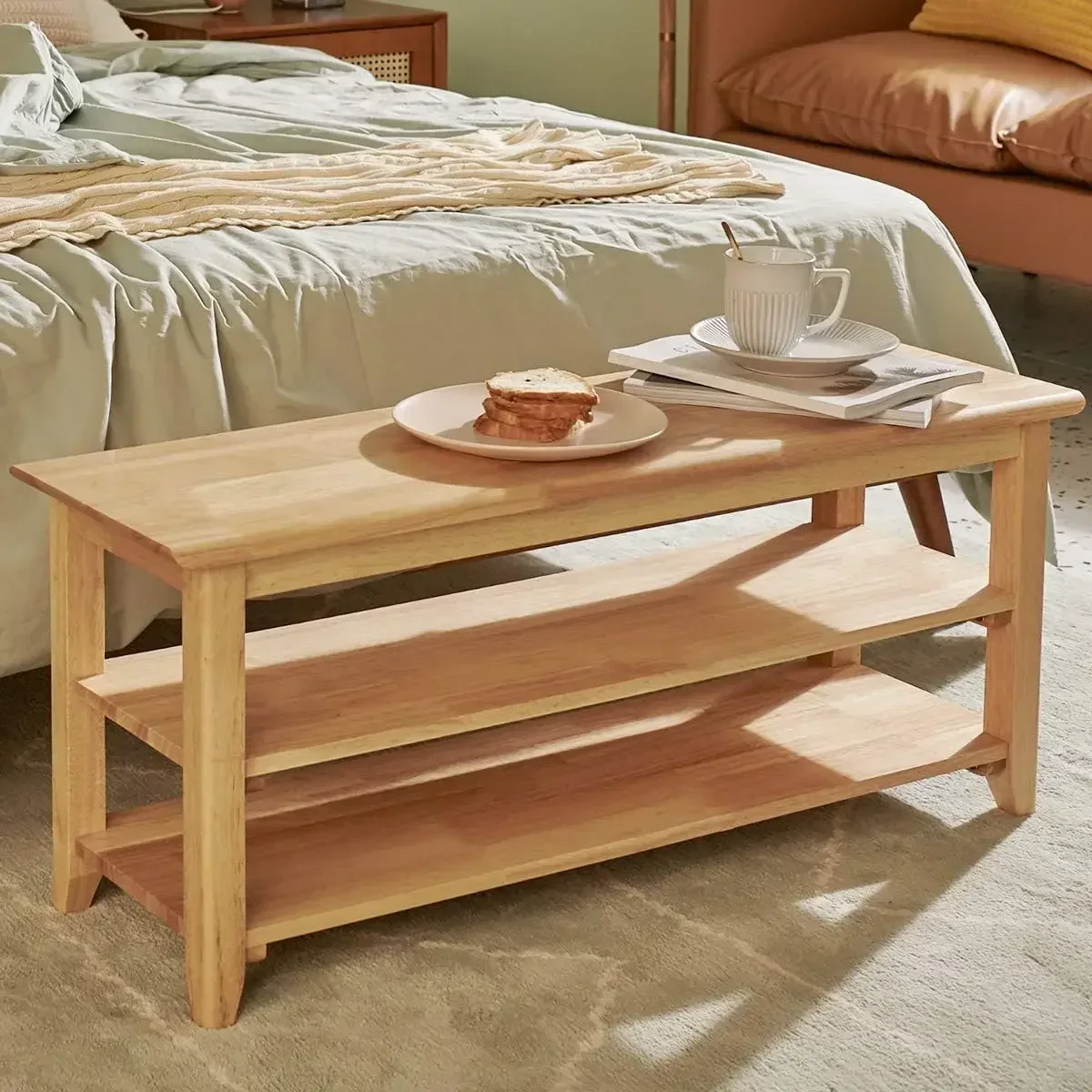
For families who need specialized storage, shoe bench mudroom solutions offer targeted functionality without unnecessary features that drive up costs. Remember that investing slightly more in quality construction and materials often provides better long-term value than choosing the absolute cheapest option available.
7. Comparing the Long-Term Value of Different Mud Bench Options
Looking beyond the initial price tag helps evaluate the true cost and value of different mud bench options over time.
| Bench Type | Initial Cost | Expected Lifespan | Annual Cost | Maintenance Requirements |
|---|---|---|---|---|
| Budget prefabricated | $50-150 | 2-5 years | $10-75/year | Frequent tightening, limited repair options |
| Mid-range prefabricated | $150-500 | 5-10 years | $15-100/year | Moderate maintenance, some repair options |
| High-end prefabricated | $500-1,000+ | 10-20 years | $25-100/year | Periodic maintenance, good repair potential |
| Custom built | $1,000-5,000+ | 15-30+ years | $33-333/year | Minimal maintenance, excellent repair options |
| DIY solid wood | $200-500+ | 10-30+ years (varies) | $7-50/year | Depends on construction quality |
Higher-quality benches typically offer:
– Greater durability under daily use
– Better resistance to damage from water and dirt
– More repair options when components wear out
– Stable construction that doesn’t loosen over time
– Classic designs that remain stylish longer
When evaluating long-term value, consider these factors:
– How heavily the bench will be used
– The number of people in your household
– Whether you plan to stay in your home long-term
– The importance of appearance and style to you
– Your willingness to perform maintenance
The top features of mudroom benches for small spaces often provide excellent value because they focus on essential functionality without wasted space or unnecessary elements. For most households, investing in the highest quality you can afford within your primary functional categories offers the best long-term value.
Entryway Bench with Cushion, Mudroom Bench with Cushion, Shoe Bench for Entryway
$1,186.63 Select options This product has multiple variants. The options may be chosen on the product pageBench with Hooks and Storage, Entryway Hall Tree, Mudroom Bench with Cubbies, Mudroom Bench with Shoe Storage
$818.38 Select options This product has multiple variants. The options may be chosen on the product pageModern Entryway Bench, Wood Entryway Bench, Wood Mudroom Bench
$497.69 Select options This product has multiple variants. The options may be chosen on the product pageEntryway Coat Rack Bench, Entryway Hall Tree, Farmhouse Mudroom Bench, Mudroom Bench with Shoe Storage
$805.09 Select options This product has multiple variants. The options may be chosen on the product pageShoe Bench for Entryway, Shoe Bench for Mudroom, Shoe Rack Bench
$477.04 Select options This product has multiple variants. The options may be chosen on the product pageEntryway Bench with Cushion, Mudroom Bench with Cabinets, Shoe Bench for Entryway, Shoe Bench with Cushion
$991.71 Select options This product has multiple variants. The options may be chosen on the product page
8. Is a Custom Mud Bench Worth the Extra Cost?
Many homeowners struggle with deciding whether to invest in a custom mud bench or choose a less expensive ready-made option. The answer depends on your specific circumstances and priorities.
When Custom Makes Financial Sense
Unusual spaces: If your entryway has non-standard dimensions, angled walls, or other architectural challenges, custom pieces will maximize every inch of available space.
Specific organizational needs: Families with unique storage requirements benefit from tailored solutions that address their exact needs rather than adapting to standardized configurations.
Long-term investment: If you plan to stay in your home for many years, the higher upfront cost of custom work amortizes into a reasonable annual investment while providing exactly what you need.
Home value considerations: Built-in custom storage can become a selling feature that adds value to your home, potentially recouping much of your investment.
When Ready-Made Is More Sensible
Temporary solutions: If you’re likely to move within a few years or want flexibility to change your setup, ready-made pieces make more financial sense.
Standard spaces: For typical entryways with no unusual constraints, many prefabricated options will fit well without the custom price premium.
Basic needs: If your storage requirements are straightforward, ready-made options likely offer all the functionality you need at a lower price point.
Tight budgets: When financial constraints are significant, a good-quality prefabricated bench now is better than waiting years to afford a custom solution.
Finding Middle Ground
Some homeowners achieve an excellent balance by:
– Purchasing ready-made pieces but having them professionally installed for a built-in look
– Starting with quality prefabricated benches and adding custom storage above
– Having a carpenter modify a ready-made bench to better fit their space
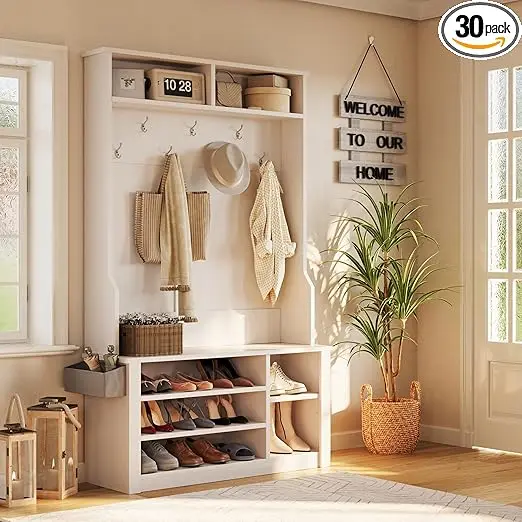
9. Frequently Asked Questions About Mud Bench Costs
How much should I budget for a basic mud bench?
For a simple, functional mud bench without extensive storage features, budget $100-300 for ready-made options. Basic models typically include a bench and perhaps a single shelf for shoes but lack closed storage or extensive organization features.
Are financing options available for higher-end mud benches?
Many furniture retailers offer financing options for purchases over a certain amount (typically $300-500), often with promotional periods of 6-24 months at 0% interest. Custom builders may offer payment plans or deposit structures to spread costs over the project timeline.
How much do installation services cost for mud benches?
Professional installation for ready-made benches typically ranges from $50-150 depending on complexity. Built-in custom benches usually include installation in their price. Wall-mounting for stability may add $25-75 to installation costs.
Can I build a quality mud bench myself without woodworking experience?
Yes, beginners can successfully build simple bench designs using pre-cut lumber, detailed plans, and basic tools. Start with straightforward designs that use straight cuts and simple joinery. Expect to spend $150-350 on materials and $100-200 on basic tools if you don’t already own them.
Does the price of a mud bench correlate directly with quality?
While there is generally a correlation between price and quality, the relationship isn’t always linear. Mid-range options ($200-500) often represent the best value, offering good quality without premium pricing. Beyond $500, you’re often paying for design aesthetics, brand names, or specialized features rather than proportional quality improvements.
Understanding what is a mudroom bench in terms of construction and materials helps evaluate whether higher prices represent genuine value or simply brand premiums. Always inspect construction details like joinery methods, material thickness, and hardware quality rather than judging by price alone.
10. Professional Installation: When to Budget for Extra Help
Even the highest quality mud bench won’t function properly if it’s not installed correctly. Understanding when to hire professional help can save time, frustration, and potential damage.
When Professional Installation Is Worth The Cost
Wall-mounted units: Any bench that attaches to the wall requires secure anchoring to studs. Improper installation risks the bench pulling away from the wall under weight.
Built-in components: Custom pieces designed to integrate with walls, floors, or other architectural elements typically require professional installation for proper fit.
Heavy or complex units: Large, heavy benches with multiple components may require specialized equipment or multiple people for safe assembly and positioning.
Electrical integration: Benches with integrated lighting, charging stations, or other electrical features should be installed by qualified professionals for safety.
Typical Installation Costs
- Basic assembly and placement: $50-150
- Wall-mounting and securing: $75-250
- Custom fitting to irregular spaces: $150-350
- Built-in electrical components: $200-500+
What’s Included in Professional Installation
Professional installation typically includes:
– Complete assembly of all components
– Secure mounting to walls, including finding studs or using appropriate anchors
– Leveling and adjusting for uneven floors
– Basic cleanup of packaging materials
– Testing of any moving parts (drawers, doors, etc.)
For benches with specialized features like bench hooks and storage, professional installation ensures these components are properly secured and functional. The complexity of multi-component storage systems often justifies professional installation even for experienced DIYers.
11. What About Mud Bench Alternatives? Cost Comparison
Before committing to a mud bench, it’s worth considering alternative solutions that might better suit your needs or budget.
Hall Trees vs. Mud Benches
Hall trees combine seating, coat storage, and often a mirror in a single freestanding unit.
– Cost range: $150-1,200+
– Advantages: All-in-one solution, typically freestanding, often includes mirror
– Considerations: Larger footprint, less customizable for unusual spaces
Simple Bench + Separate Storage
Pairing a basic bench with wall-mounted storage offers flexibility.
– Cost range: $100-500+ ($50-200 for bench, $50-300+ for separate storage)
– Advantages: Easily reconfigurable, can spread costs over time, mix and match styles
– Considerations: May look less cohesive, requires separate installation
Repurposed Furniture
Transforming existing furniture can create unique, budget-friendly solutions.
– Cost range: $50-300+ (depending on original piece and modifications)
– Advantages: Unique character, potential cost savings, sustainability
– Considerations: Requires creativity and some DIY skills, may lack purpose-built features
Built-in Closet Systems
Converting an entryway closet into an organized mudroom space.
– Cost range: $300-2,000+
– Advantages: Contained within existing space, can be closed off when not in use
– Considerations: Requires existing closet space, less accessible than open solutions
For homes with limited square footage, organize small entryway bench strategies can help maximize functionality even without a dedicated mudroom. The best solution depends on your specific space constraints, budget, and organizational needs.
12. How to Maintain Your Mud Bench to Protect Your Investment
Proper maintenance extends the life of your mud bench and preserves its appearance, protecting your investment over time.
Material-Specific Maintenance
Wood Maintenance:
– Dust regularly with a soft, dry cloth
– Clean spills immediately to prevent water damage
– Apply furniture polish or wax 2-4 times yearly to maintain finish
– Re-oil unfinished or oil-finished wood every 3-6 months
Metal Components:
– Wipe clean with a damp cloth
– Apply appropriate metal polish for shiny finishes
– Check periodically for rust and address immediately
– Tighten any loose screws or fasteners
Upholstered Elements:
– Vacuum regularly to remove dust and debris
– Treat stains promptly with appropriate cleaners
– Consider fabric protection sprays for prevention
– Rotate or flip cushions to ensure even wear
Seasonal Maintenance Recommendations
Spring:
– Deep clean all surfaces
– Check for winter damage from snow, salt, and moisture
– Tighten any components loosened by humidity changes
Fall:
– Prepare for heavy use during winter months
– Apply protective finishes before the wet season
– Check structural integrity of all weight-bearing elements
Cost-Effective Maintenance Products
Basic maintenance supplies are relatively inexpensive:
– Quality wood polish/conditioner: $8-15
– Furniture repair markers for scratches: $8-12
– Hardware tightening kit: $10-20
– Fabric/upholstery cleaner: $5-15
Investing small amounts in regular maintenance prevents costly repairs or premature replacement, significantly extending the usable life of your mud bench.
13. Should You Buy Now or Wait? Price Trends for Mud Benches
Understanding price trends helps you time your purchase for maximum value. While individual needs should drive your timing, certain patterns can help you make a more economical decision.
Seasonal Price Variations
Furniture prices, including mud benches and entryway furniture, typically follow predictable seasonal patterns:
– January and July: Semi-annual furniture sales with discounts of 15-30%
– End of summer (August-September): Back-to-school season often features organizational furniture sales
– November-December: Holiday sales, particularly Black Friday and year-end clearances
Material Cost Influences
Raw material prices, particularly wood, can significantly impact mud bench pricing:
– Lumber prices fluctuate seasonally and with market conditions
– Manufacturing and shipping costs are reflected in retail pricing
– Energy price increases often lead to furniture price increases with a 3-6 month lag
Balancing Timing with Need
Consider these factors when deciding whether to buy now or wait:
– Immediate organizational needs may outweigh potential savings from waiting
– Seasonal sales typically offer 10-25% discounts, which may be worth waiting for if timing aligns with your needs
– Special order or custom pieces rarely see significant discounting, so timing matters less
– Display models or floor samples often see deeper discounts (30-50%) when retailers update inventory
For most homeowners, the functional benefits of having an organized entryway outweigh the potential savings from extended waiting. If your purchase timeframe is flexible, aim for major sale periods, but if you need organization solutions now, the daily utility likely justifies the purchase even at regular pricing.


